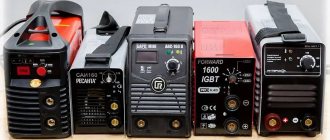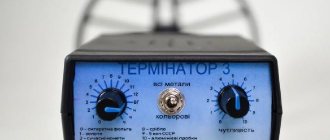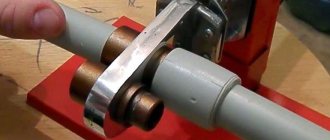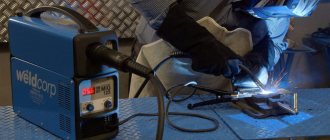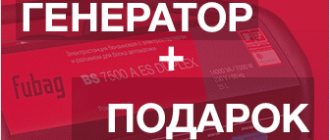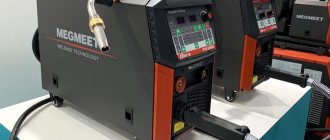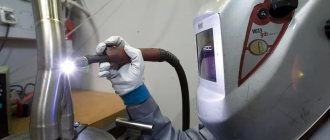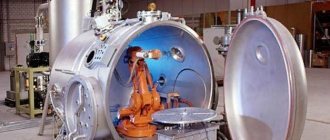Welding is a technological process in which a large number of parameters and factors must be taken into account. The greatest control over welding characteristics is required when argon-arc welding TIG with a non-consumable electrode in an environment of protective inert gases. Therefore, to simplify monitoring of a number of parameters in welding inverters, a cyclogram is used.
Using a cyclogram, the welder sets the necessary welding parameters so that the process does not cause difficulties, as well as to prevent various defects. Let's look at the cyclogram of the welding machine PTK MASTER TIG 200 P AC/DC D92.
Each parameter of the cyclogram is important, so to obtain high-quality welded joints you need to understand why it is needed and how to configure it. Let's take a closer look at each of them.
Gas supply time before welding
This is a parameter that increases the delay time for the high-frequency oscillator to operate, while the gas valve in the device is in the open position, thereby supplying shielding gas to the burner. Typically has an adjustment range from 0.1 to 10–15 seconds. Adjusting this parameter allows you to expel excess oxygen from all channels of the argon-arc torch so that it does not enter the welding zone and fill the welding seam with vapors, because inert gases are heavier than air and displace oxygen from the welding zone.
Advice. The recommended gas supply time is from 1.0 to 2.0 seconds. This is quite enough to expel air from all channels and not waste shielding gas in vain.
Advantages and disadvantages of the method
The main advantages include:
- Displacement of air by argon from the area where welding occurs. Thanks to this, the seam is obtained without defects.
- Possibility of welding different metals.
- High quality seam.
- Low heating of parts, which eliminates their deformation.
- Working with metals that are difficult to weld.
- Ability to work with structures of different sizes.
- Fire safety.
- No waste.
- Isolation from the influence of the external environment.
- Electric arc stability.
- Versatility.
- Ability to work with thin metal sheets.
- Small heating zone of the product.
- Learning what TIG welding is is not difficult.
- Protecting the surface from oxide film.
- No need for additional processing after welding.
- Good control over the condition of the weld pool.
- Possibility of surfacing during restoration and restoration work.
- Possibility of using direct and reverse polarities.
- The compactness of the inverter with this function.
- Various TIG welding modes.
Disadvantages of the method:
- Low performance.
- Slow process speed.
- High cost of the equipment used.
- Availability of professional skills.
- Ineffective work in drafts or strong winds. It is necessary to install special shields and increase the supply of argon, which leads to its overconsumption.
- The need for preliminary surface preparation.
- Difficulty working in hard-to-reach places.
Provided that the shortcomings are not too significant, the use of this method is justified.
Peak current
Or the main current for arc welding without a pulse is the main welding parameter that forms the weld pool and weld seam. When welding with a pulsed arc, this is the upper limit of the welding current, which also forms the weld seam. Typically has a range from 5–15 Amps to the maximum welding current of the machine.
Advice. It is better to set the starting current to a higher peak (main) current of 10–20 Amps in order to quickly form a weld pool without further overheating of the base metal. It is better to set the current decay time from 1.5 to 2.0 seconds, so as not to heat the metal for a long time and not get burned.
Electrode selection
The technology of welding aluminum with argon also requires the correct choice of a tungsten electrode, the diameter of which should be as close as possible to the thickness of the parts being welded. Sharpening is done in the classic way, but without a sharp tip, as is the case with stainless steel welding. During the first seconds of combustion, the electrode will take the shape of a drop at the end and the seam will have to be made this way. The projection from the nozzle is required to be 3-5 mm to avoid overheating of the tungsten. When welding, small spatters of aluminum will stick to the electrode, requiring re-sharpening.
Learning to weld aluminum is not easy. But knowing the above principles and watching videos with lessons from experts, you can confidently try your hand at practice.
Source: svarkalegko.com
Article rating:
Save to:
Argon arc welding, setting up the machine Link to the main publication
Base current
An indicator that, in combination with the peak current, produces a pulsed arc with a certain frequency that can be adjusted. The base current sets the lower limit of the pulse. Used when welding thin sheet metal to prevent overheating, burnout of alloying elements, burns and warping. The base current allows you to keep the weld pool from failure and from burning through. The standard adjustment range is from 5–15 Amps to the maximum value of the welding current of the machine.
This parameter will only be active in AC Pulse and DC Pulse mode, i.e. when welding with a pulsed arc, in other modes this parameter will not work.
Safety regulations
When welding, we must not forget about safety rules. It is necessary to use protective equipment for the welder: a mask or shield, gloves or leggings, special clothing and shoes.
All masks can be divided into active and passive. The sight glass of passive masks is permanently darkened. In active ones, darkening occurs only as a reaction to a light flash from the arc. The advantage of this option is that while the welding process is stopped, the glass becomes transparent and the welder can clearly see the object. There is no need to lift the glass, which is quite convenient.
Main types of welding gaiters:
- Canvas . They are not in demand because they do not perform well the main function of protecting hands from high temperatures and sparks. They easily burn when exposed to sparks.
- Split fibers . Made from specially treated leather from pigs or cows. Resistant to flying sparks. Durable, elastic, hygienic. Does not restrict hand movements. If there is a cotton layer inside, it keeps your hands warm.
- Felt . Convenient for welding work.
There are combined models that use different types of materials. Welding gaiters come in length up to the elbow and cover only the hand. The possibility of tightening the edge of the glove provides additional safety.
A welder's suit must be made of high quality materials. It must be resistant to splashes of molten metal. The requirements for a welder's suit are specified in GOST 12.4.250. The main parts of the suit are the jacket and trousers. The material from which they are made must have great heat resistance. According to the regulatory material, the jacket must cover the trousers by more than 20 cm. The fasteners are closed with flaps. The maximum distance between them on the jacket is 15 cm.
Safety regulations include electrical safety. The argon cylinder must be located at a distance of at least 5 meters from possible sources of fire. The cylinder must be placed vertically and secured to prevent it from falling. Before work, it is necessary to check the condition of the hoses.
TIG welding machines
Article: 005.100.302 PTK MASTER TIG 200A F55
Direct current (DC) argon arc welding machine. Availability of an additional function of manual arc welding. 2 year warranty.
Price: RUB 30,590
5 year warranty Article number: 005.300.471 PTK RILON TIG 200 P AC/DC GDM
Device for argon arc welding with direct (DC) and alternating current (AC). Pulse welding. Manual arc welding (MMA) function. 5 year warranty.
Price: RUR 90,770
5 year warranty Article number: 005.300.371 PTK RILON TIG 200 P GDM
Direct current (DC) argon arc welding machine. Pulse mode for welding metal of small thicknesses. Manual arc welding (MMA) function. 5 year warranty.
Price: RUR 47,560
5 year warranty Article: 005.300.301 PTK RILON TIG 200 CT
Direct current (DC) argon arc welding machine. Manual arc welding (MMA) function. 5 year warranty.
Price: RUR 42,120
5 year warranty Article: 005.300.406 PTK RILON TIG 315 P AC/DC
Industrial welding machine TIG 315 AC/DC, which is ideal for welding aluminum and its alloys, as well as all types of steel, nickel and copper. Welding on direct and alternating current with pulse. Additional MMA welding function. 5 year warranty.
Price: RUB 133,290
Article: 005.100.373 PTK MASTER TIG 200 P AC/DC D92
Device for argon arc welding with direct (DC) and alternating current (AC). Pulse welding and the presence of an additional function of manual arc welding (MMA). 2 year warranty.
Price: RUB 71,600
Article: 005.100.372 PTK MASTER TIG 200 PULSE D91
Direct current (DC) argon arc welding machine. Pulse mode for welding metal of small thicknesses. MMA welding with hot start and arc afterburner settings is possible. 2 year warranty.
Price: RUB 36,750
Article: 005.200.403 PROFI TIG 315 P AC/DC
Welding inverter for industrial use from a network of 380±15%. Used for direct current (DC) argon arc welding and alternating current (AC) aluminum welding. Availability of MMA welding. Connection to the remote control. The burner is connected to the BJO.
Price: RUB 121,230
Article: 005.200.401 PROFI TIG 200 P AC/DC
Device for industrial use from a network of 220±15%. Used for direct current (DC) argon arc welding and alternating current (AC) aluminum welding. Availability of MMA welding. Connection to the remote control.
Price: RUR 81,800
Areas of application
TIG technology is used in:
- shipbuilding;
- production of cars and aircraft;
- obtaining parts of various machines and mechanisms;
- manufacturing of medical equipment;
- production of household and professional power tools.
This technique allows you to successfully weld products made of ferrous metal - cast iron and steel. You can perfectly weld, say, carbon and stainless steel workpieces. There is no need to carefully select the filler material - almost any option will do. Along with pure tungsten tools, tungsten-containing structures can also be used. Cast iron has to be preheated. Working with alloyed steels and steels containing a lot of carbon is possible if they do not experience strong mechanical loads; in addition, it is necessary to protect the metal from excessive heat.
TIG welding of aluminum with direct current has almost fallen out of use in recent years. The method itself is characterized by increased cost. Therefore, it is used mainly where high demands are placed on the products themselves and their connections. Full-fledged work can only be performed in industrial production conditions. In a private home or small workshop, serious problems usually arise.
The TIG method can also cook copper products relatively well. This option allows you to get a very beautiful seam. It is imperative to take into account the fluidity of the copper melt and the increased thermal conductivity of this metal. Strong heating of copper leads to the appearance of refractory components that are characterized by increased fragility. It is impossible to create vertical or ceiling seams - all because of the same special fluidity of the metal.
Technological process
Despite the fact that argon arc TIG welding requires skill and professional knowledge, it can be done with your own hands. Before this, you need to understand what TIG welding is in principle, what equipment is needed, and the sequence of actions.
Stages of assembling the welding machine:
- Connection of the oscillator to the inverter.
- Attaching the wire responsible for ground to the terminal with a plus sign.
- Attaching the wire connected to the burner to the terminal with a minus sign.
- Attaching the burner to the sleeve through which the gas passes.
- Preparing an argon cylinder. Gearbox winding.
- Attaching the gas supply hose to the reducer.
- Connecting the inverter to a 220 V network. The oscillator is powered by a 6 V unit.
Do-it-yourself argon arc welding in manual mode has the following algorithm:
- Cleaning the surface where welding will be done.
- Preparing the burner for operation.
- Argon supply.
- Ignition of the arc.
- Start of welding.
For cleaning, you can use mechanical or chemical methods. Cleaning must be completed by degreasing. Gas should be supplied a few seconds before connecting the power source. This will ensure the appearance of a protective layer.
Important! In order for a small welding arc to be created, the electrode must be located at a distance of at least 2 mm from the surface to be welded.
After igniting the arc, you can begin the welding process. With the torch in his left hand, the welder draws an arc along the seam, and with his right hand he moves the wire towards the movement of the torch. The electrode and wire should form an angle of approximately 90°. Sharp wire feeding is unacceptable, as this can lead to splashes of hot metal and the formation of an uneven seam.
